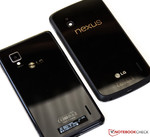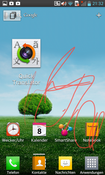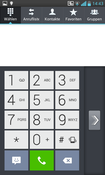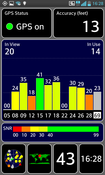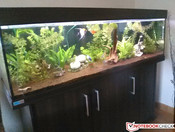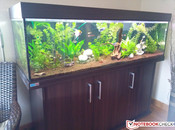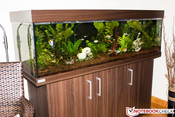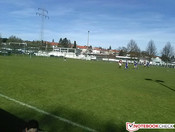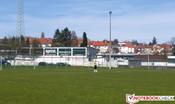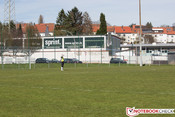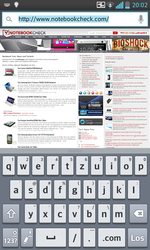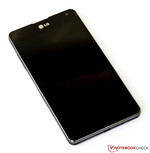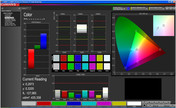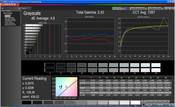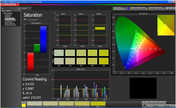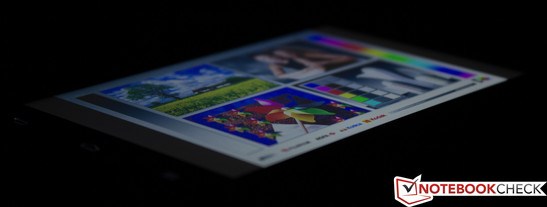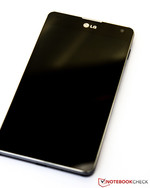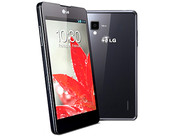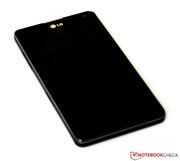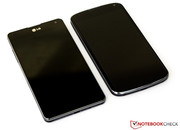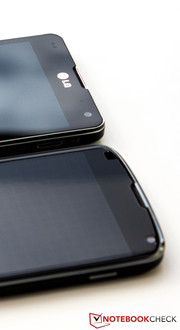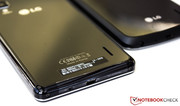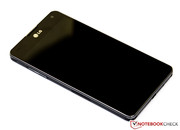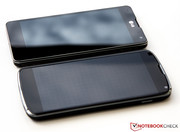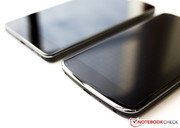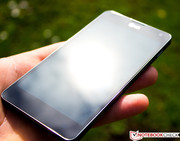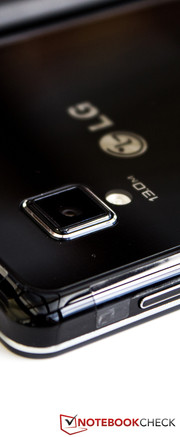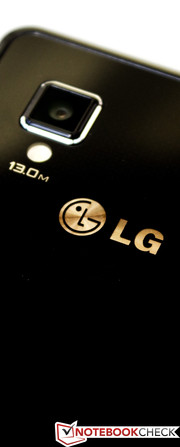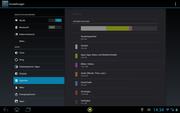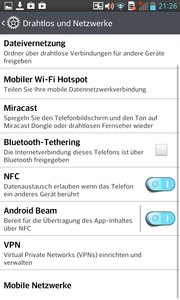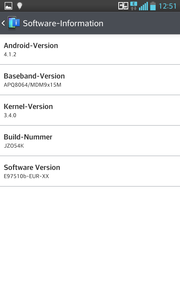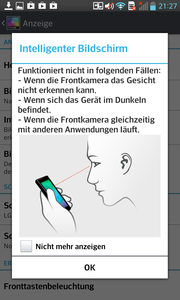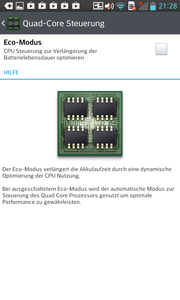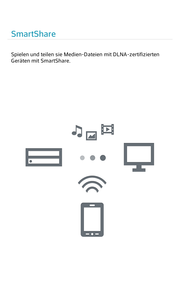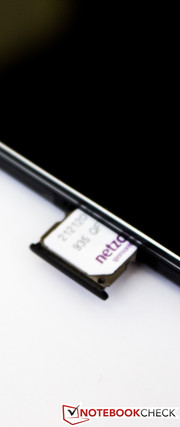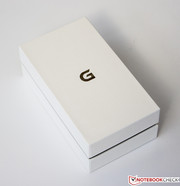Review LG Optimus G E975 Smartphone

For the original German review, see here.
The new flagship device from LG reached us quickly after its launch. The technical specifications of the smartphone are certainly impressive but there is already an enhancement – more on that later. The LG E975 Optimus G is equipped with a Snapdragon S4 Pro and a 4.7-inch display. The SoC provides four processor cores with a clock of 1.5 GHz each that are supported by 2 GB memory. Contrary to the current maximum resolution of 1920x1080 pixels the LCD-IPS panel only has 1280x768 pixels. The integrated storage is not very flexible without a micro SD slot; however our review unit has 32 GB storage, which should be sufficient for most users.
We noticed conspicuous similarities in terms of technical features and also during a first handling of the device. If LG was not the manufacturer of the Google Nexus 4 there might be a legal dispute. Just replace the rounded corners of the Nexus 4 with a more edged design and you basically get the Optimus G. So why would you buy the considerably more expensive LG Optimus G?
Case
The case is probably the biggest difference of the two high-end devices, although the used materials are very similar. The often discussed glass rear surface of the Nexus 4 can also be found on the Optimus G, only the pattern of the marbling was slightly changed. If LG did not improve the material, the smartphone should have the same problem as its sibling after an unfavorable drop – splintered glass at the front and back. LG uses polycarbonate with a glossy finish at the sides and it leaves a slightly cheaper impression compared to the Google device. If we have a look at the size of the brand-new HTC One we can see that the Optimus G is thinner (HTC One: 137.4 x 68.2 x 9.3 mm). With 131.9 x 68.9 x 8.45 mm (width x height x depth) and a weight of 145 grams the smartphone lies comfortably in the hand and does not occupy too much space in the pocket.
The device is highly torsion-resistant and also resistant against concentrated pressure. The build quality is on a very high level in regard to the feel and the looks. Despite the lack of aluminum the Optimus G certainly does not have to hide behind the HTC One. The device is currently only available in one color – black. It is the same situation with the storage, if you want the LG flagship device you have to buy the 32 GB version.
Connectivity
If you already used the Google Nexus 4 the control elements of the Optimus G will be familiar. Even the layout of the sensors and ports is identical, sometimes down to the millimeter. Starting at the top we find the 3.5 mm stereo jack, the power button is on the upper right side. It can be easily reached; operating the device with one hand is no problem especially for right-handers. The volume rocker and the micro-SIM slot are on the other side. Via the micro USB port at the bottom the device can be used as a removable drive for computers. It can also be used for charging, of course. You can use an MHL adaptor for the micro USB port to stream the display content to a TV. There is no storage extension via micro SD card but 32 GB should be sufficient for most users anyway.
Software
The Nexus 4 has an important advantage compared to the Optimus G when it comes to the operating system. Even though both devices are manufactured by LG the Google smartphone gets the latest software updates earlier. While the Nexus 4 already uses Android 4.2.2 the LG Optimus G is still based on Android 4.1.2. LG’s own launcher, LG S-Class comes preinstalled. It does not have a lot of adjustments or visual highlights. One additional application is QuickMemo. It can be activated via notification bar and enables taking notes on the home screen.
People that have already tried alternative launchers in the past will most certainly use additional software from the Google Play Store. Some popular launchers are Go Launcher EX, Apex Launcher and ADWLauncher EX. Unfortunately our review unit also has some bloatware. LG preinstalls several applications, only some of them can be deleted. Some applications, for example Smart Share, can only be deleted with root access.
Telephone
The telephone function is pretty similar to previous Android versions. The layout is slightly adjusted by LG’s own LG S-Class launcher but the functions are still the same. Even for Android newcomers the intuitive user interface should be no problem. With the function One-hand Operation the keyboard becomes smaller and the buttons are easier to reach.
Communication & GPS
Every smartphone needs WLAN, the only difference is usually the transfer rate. Our review unit receives and transmits via WLAN 802.11 b/g/n and uses a Bluetooth 4.0 module for data transfer between compatible devices. A big difference compared to the Google Nexus 4 is the integrated LTE module (800/1,800/2,600 MHz). If you can use LTE with your data plan web browsing with download speeds of up to 100 Mbit/s is possible (uploads up to 50 Mbit/s).
Navigation applications can use the assisted-GPS module. Even indoors the connection can be established but the accuracy could be better. Outdoors we get an acceptable and stable result. LG also integrated an NFC-module into the Optimus G to complete the package.
Cameras & Multimedia
Compared to the 8 MP camera of the Nexus 4 the Optimus G has an enhanced module with 13 MP. The main camera is supported by an LED flash. The front camera is noticeably weaker with just 2 MP. The main camera also records video in Full HD quality. Besides the standard camera features LG integrated some additional functions. The interesting Photo-Sphere feature from the Nexus 4 is not available but the user can use voice commands, for example. The Snapshot mode is very interesting; the camera is used as normal, however it takes one picture before and one picture after the actual triggering. Afterwards the user can look at the pictures and select the best one. Continuous shooting or panoramas are no problem either.
The quality of the main camera is good; the picture details meet the camera requirements of a high-end device. The whole picture is slightly darker than the reference picture due to the smaller sensor; this results in more colorful pictures. Indoors the results of the camera are solid. Picture noise can only be seen in small areas and the color presentation is good. The flash was in the automatic setting but it was not used. The front camera only shows little details in both scenarios and also shows significant noise indoors. The quality is just sufficient for a webcam but an upgrade would have been appreciated.
Accessories & Warranty
The accessories are reasonable, besides the modular power supply unit and the tool for the micro-SIM slot there is an in-ear headset in the box. Basic instructions can be found in the quick start guide.
LG is generous in regard to the warranty period, 24 months is not standard anymore. For instance, all Apple devices only come with a 12-month warranty. A small drawback is the battery warranty with just six months. You can contact LG via their website or hotline in case of a problem.
Input Devices & Handling
Handling and navigating through the operating system completely waives hardware buttons. The three capacitive buttons beneath the keyboard react quickly and accurately. The same applies to the 4.7-inch display; it gives no cause for criticism – quite the contrary. Operating the device with the display is very convenient and also very fast. We could not determine any micro stutters or other lags. The preinstalled keyboard is easy to use; the key size is sufficient and you can still see enough of the content in portrait mode. In landscape mode the virtual keyboard occupies more than 50% of the screen.
LG removed one criticism of the Nexus 4. The navigation buttons are not part of the display anymore, the full 4.7-inches can be used. With the Nexus 4 7 millimeters of the display was always occupied.
Display
The main input device of a smartphone is the display; our review unit uses a True HD IPS+ Color display. It can show up to 16.7 million colors with a resolution of 1280x768 pixels (WXGA). We are not sure why LG decided not to integrate a Full HD display in the Optimus G. Current high-end devices like the HTC One or the Xperia Z already use this display technology. Accordingly the pixel density is noticeably lower; the combination of resolution and size results in 319 ppi (HTC One: 469 ppi).
We determine the maximum display brightness (436 cd/m²) in the center left. The average brightness is calculated with nine measurements at different spots and results in 393.6 cd/m². The Optimus G is slightly behind the Nexus 4 and HTC One (488.9 cd/m²) in terms of brightness.
| |||||||||||||||||||||||||
Brightness Distribution: 86 %
Center on Battery: 426 cd/m²
Contrast: 1039:1 (Black: 0.41 cd/m²)
The Optimus G falls behind when we have a look at the brightness distribution. With 86% it cannot keep up with the 93% of the Nexus 4 or the 90% of the HTC One. The situation is similar in regard to contrast and black value. 1,039:1 or 0.41 cd/m² respectively are very good results, however the two other panels already show a technical enhancement.
With the help of CalMAN 5 software we determine the color accuracy, saturation and grayscale presentation. The RGB balance of our review unit shows a blue cast, which also leads to weak red colors. The DeltaE value of 5 shows that all colors are in an acceptable area. This also supports the subjective impression of an accurate color presentation.
Performance
We are already familiar with the hardware of the Optimus G; many older smartphones use similar components. However, this does not mean the technical specifications are not up to date. The Qualcomm Snapdragon S4 Pro is one of the best components available and shows impressive performance. The SoC (System-on-a-Chip) is manufactured in a 28 nm process and supports the ARMv7 instruction set. Graphics are handled by the Adreno 320 GPU; to avoid future performance limitations LG integrated 2 GB memory.
The cross-platform benchmark 3DMark Ice Storm shows that the latest software of the Nexus 4 results in a slight performance increase. With identical hardware the Google smartphone can manage an advantage of up to 17%. Other benchmarks deliver mixed results. The Optimus G takes the lead in the Onscreen-section of GLBenchmark 2.5 but falls behind in every other test. All of our comparison devices have high-end hardware; the performance differences can only be seen in benchmarks.
| GLBenchmark 2.5 | |
| Egypt HD Fixed Time (sort by value) | |
| LG Optimus G E975 | |
| Google Nexus 4 | |
| HTC One | |
| Samsung Galaxy S3 | |
| 1920x1080 Egypt HD Offscreen Fixed Time (sort by value) | |
| LG Optimus G E975 | |
| Google Nexus 4 | |
| HTC One | |
| Samsung Galaxy S3 | |
| AnTuTu v3 - Total Score (sort by value) | |
| LG Optimus G E975 | |
| Google Nexus 4 | |
| HTC One | |
| Samsung Galaxy S3 | |
| 3DMark | |
| 1280x720 Ice Storm Standard Score (sort by value) | |
| LG Optimus G E975 | |
| Google Nexus 4 | |
| HTC One | |
| 1280x720 Ice Storm Standard Graphics (sort by value) | |
| LG Optimus G E975 | |
| Google Nexus 4 | |
| HTC One | |
| 1280x720 Ice Storm Standard Physics (sort by value) | |
| LG Optimus G E975 | |
| Google Nexus 4 | |
| HTC One | |
| Linpack Android / IOS | |
| Single Thread (sort by value) | |
| LG Optimus G E975 | |
| Google Nexus 4 | |
| HTC One | |
| Samsung Galaxy S3 | |
| Multi Thread (sort by value) | |
| LG Optimus G E975 | |
| Google Nexus 4 | |
| HTC One | |
| Samsung Galaxy S3 | |
The results are very clear in the browser based benchmarks. The Optimus G is always behind the HTC One; the aluminum device manages an advantage of up to 71%. With the exception of Sunspider 0.9.1 even the older Samsung Galaxy S3 performs better than our review unit.
| Google V8 Ver. 7 - Google V8 Ver. 7 Score (sort by value) | |
| LG Optimus G E975 | |
| Google Nexus 4 | |
| HTC One | |
| Samsung Galaxy S3 | |
| Browsermark - --- (sort by value) | |
| LG Optimus G E975 | |
| Google Nexus 4 | |
| HTC One | |
| Samsung Galaxy S3 | |
| Peacekeeper - --- (sort by value) | |
| LG Optimus G E975 | |
| Google Nexus 4 | |
| HTC One | |
| Samsung Galaxy S3 | |
| Sunspider - 0.9.1 Total Score (sort by value) | |
| LG Optimus G E975 | |
| Google Nexus 4 | |
| HTC One | |
| Samsung Galaxy S3 | |
| Octane V1 - Total Score (sort by value) | |
| LG Optimus G E975 | |
| Google Nexus 4 | |
| HTC One | |
| Samsung Galaxy S3 | |
* ... smaller is better
We use the AndroBench 3 benchmark to determine the performance of the flash storage. The results show no significant limitations; sequential reads are better compared to those of the HTC One. The picture is different with sequential writes, now the Optimus G falls behind by 18%.
| AndroBench 3-5 | |
| Random Write 4KB (sort by value) | |
| LG Optimus G E975 | |
| Google Nexus 4 | |
| HTC One | |
| Samsung Galaxy S3 | |
| Random Read 4KB (sort by value) | |
| LG Optimus G E975 | |
| Google Nexus 4 | |
| HTC One | |
| Samsung Galaxy S3 | |
| Sequential Write 256KB (sort by value) | |
| LG Optimus G E975 | |
| Google Nexus 4 | |
| HTC One | |
| Samsung Galaxy S3 | |
| Sequential Read 256KB (sort by value) | |
| LG Optimus G E975 | |
| Google Nexus 4 | |
| HTC One | |
| Samsung Galaxy S3 | |
Games & Videos
Top score and unlimited compatibility. Currently there seems to be no game in the Google Play Store that could bring the Optimus G to its performance limits. Need for Speed: Hot Pursuit is certainly a demanding game - yet not demanding enough for the quad-core processor and the Adreno 320 GPU. Video playback is no problem either; we checked the multimedia capabilities with several sample videos (MKV). Even data rates above 6,000 kbit/s were no problem.
After multiple conversations we can say that the voice quality is okay. However, we were able to recognize a slight cracking noise but this was only the case for the Optimus G; the recipient could not confirm this impression. Otherwise voices were clear; the integrated speaker is loud but does not sound very good.
Emissions
Temperature
Compared to the Nexus 4 LG managed to improve the heat development and the heat dissipation. Under load we measure an average temperature of 35.4 °C at the front of the review unit. That is 2.4 °C less than the Nexus 4 but still 1.7 °C more than the aluminum case of the HTC One. During idle the temperature drops to 27.4 °C at the front and 26.4 °C at the back. The improved temperature management of the Optimus G is even more evident in this scenario; the Nexus 4 remains between 33.9 and 34.7 °C. The temperature of the PSU is unproblematic with a maximum of 38.3 °C during charging.
(±) The maximum temperature on the upper side is 41.9 °C / 107 F, compared to the average of 35.2 °C / 95 F, ranging from 21.9 to 247 °C for the class Smartphone.
(±) The bottom heats up to a maximum of 41.4 °C / 107 F, compared to the average of 34 °C / 93 F
(+) In idle usage, the average temperature for the upper side is 27.4 °C / 81 F, compared to the device average of 32.9 °C / 91 F.
Speaker
Nothing really changed in this regard. The speaker is on the lower right side at the back. The sound is very tinny and the speaker creates distortions at high volumes. We definitely see room for improvement here; enjoyable music playback sounds different.
Power Management
Energy Consumption
LG not only improved the heat dissipation but also the energy consumption. The difference to the Nexus 4 is not very significant during idle, our review unit consumes between 0.4 and 1.4 Watts (Nexus 4: 0.7 up to 1.4 Watts). The improvement can really be seen under load; the savings are impressive. While the latest Google smartphone consumes between 3.9 and 6.5 Watts the Optimus G is more frugal with 2.8 up to 3.7 Watts. Despite the identical manufacturing process of the Snapdragon 600 (28 nm process) this SoC seems to be more frugal. The HTC One can run the four cores, the GPU and the significantly brighter display with 0.4 up to 4 Watts in all scenarios.
| Off / Standby | |
| Idle | |
| Load |
|
Key:
min: | |
Battery Runtime
The non-removable battery has a capacity of 2,100 mAh. Under load (simulated by the Stability Test) the battery is empty after 3 hours and 30 minutes. We determine a longer runtime in the more realistic WLAN-scenario; it is considerably higher due to the lower consumption in the individual sections. The Optimus G has to be recharged only after 11 hours and 10 minutes. The runtime during idle is higher with 18 hours and 15 minutes. All in all, the runtimes are average and the ambitious user will have to charge the smartphone every day. A complete charge takes 3 hours and 32 minutes when the device is turned on.
Verdict
The latest smartphone from South Korean manufacturer LG shows strong similarities to the Google Nexus 4, both visually and technically. That is not really surprising since LG is also the manufacturer of the current Google smartphone. Qualcomm's Snapdragon S4 Pro is used as the SoC; it has four cores clocked at 1.5 GHz and is supported by 2 GB RAM. The display is 4.7-inches and is noticeably brighter than the Google Nexus 4 - in return black value and contrast are worse. LG improved the energy consumption and was able to reduce it significantly, this can also be seen in the lower temperatures and the longer battery runtimes. The flagship device is also future-proof with an integrated LTE module.
The small drawbacks of the Nexus 4 are gone and you can now, for example, use the whole display thanks to the relocation of the navigation bar. In addition the LG Optimus G now has a larger 32 GB flash storage. All these points justify the higher retail price. The Nexus 4 is currently available for 349 Euros (~$455) in the Google Play Store, the new Optimus G is at least 100 Euros (~$130) more expensive. In return you get many advantages, for example the longer warranty (24 months), but no real drawbacks.




